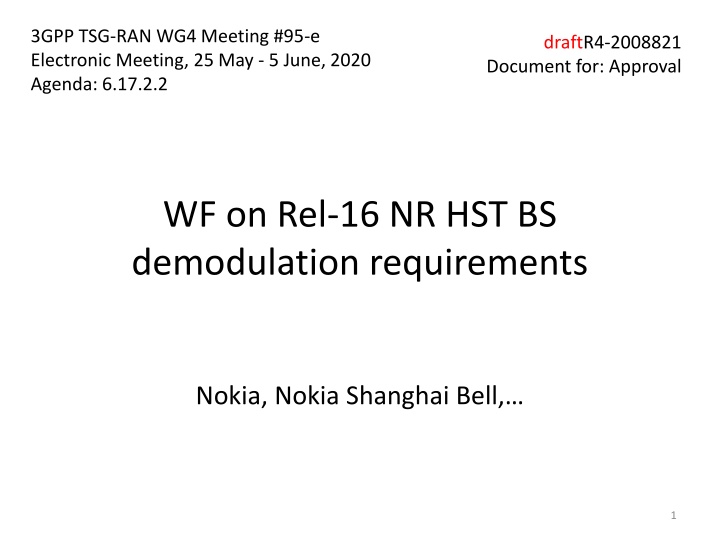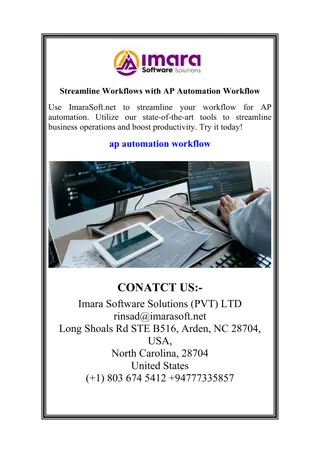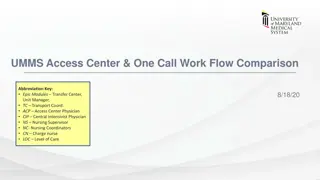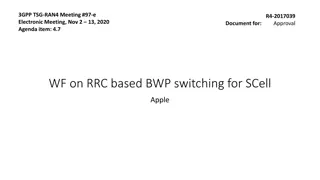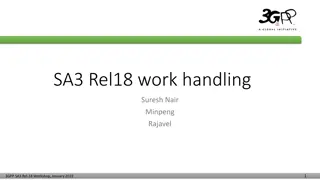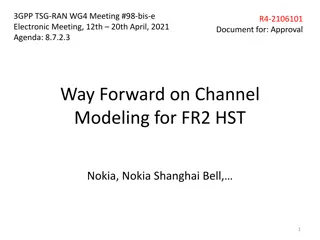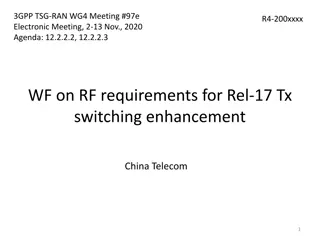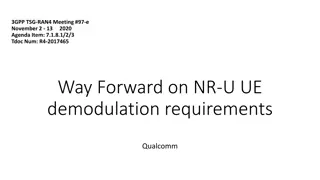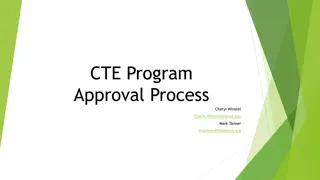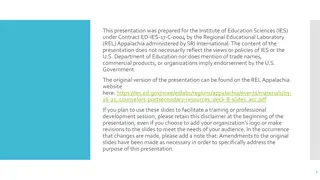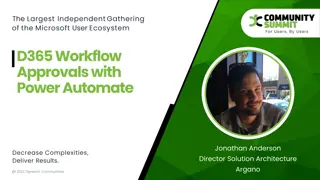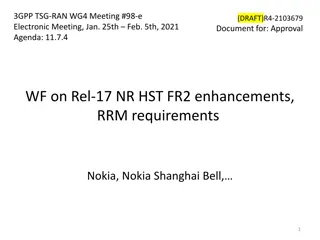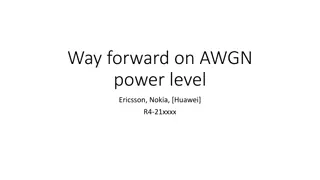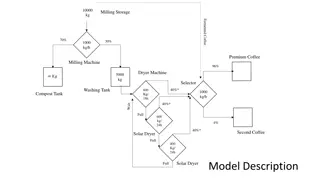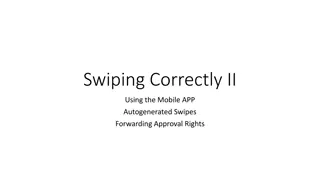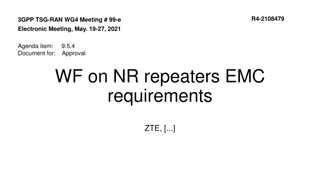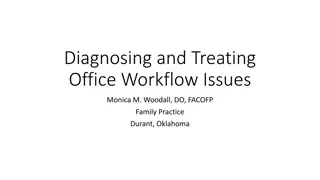Approval Workflow for Rel-16 NR HST BS Demodulation Requirements
In the TSG-RAN-WG4 Meeting #95-e, various Workflows (WFs) were agreed upon for different scenarios including PUSCH, PRACH, and UL TA. The focus was on defining demodulation requirements for high-speed trains (HST) in the context of 5G NR technology. Manufacturers declared support options for HST scenarios, such as maximum speeds, PRACH formats, and high-speed modes. Specific requirements for PUSCH in tunnel scenarios were also addressed.
Download Presentation

Please find below an Image/Link to download the presentation.
The content on the website is provided AS IS for your information and personal use only. It may not be sold, licensed, or shared on other websites without obtaining consent from the author.If you encounter any issues during the download, it is possible that the publisher has removed the file from their server.
You are allowed to download the files provided on this website for personal or commercial use, subject to the condition that they are used lawfully. All files are the property of their respective owners.
The content on the website is provided AS IS for your information and personal use only. It may not be sold, licensed, or shared on other websites without obtaining consent from the author.
E N D
Presentation Transcript
3GPP TSG-RAN WG4 Meeting #95-e Electronic Meeting, 25 May - 5 June, 2020 Agenda: 6.17.2.2 draftR4-2008821 Document for: Approval WF on Rel-16 NR HST BS demodulation requirements Nokia, Nokia Shanghai Bell, 1
Background Agreed WFs for PUSCH in previous meetings R4-1910128 Way forward on NR HST BS demodulation requirements, RAN4#92. R4-1912809 Way forward on NR HST PUSCH demodulation requirements, RAN4#92Bis. R4-1915886 Way forward on NR HST PUSCH demodulation requirements, RAN4#93. R4-2002405 WF on Rel-16 NR HST BS demodulation requirements, RAN4#94e. (The content in WF R4-2002405 except slide 16 is agreed; see meeting minutes.) R4-2005534 WF on Rel-16 NR HST PUSCH BS demodulation requirements, RAN4#94-e-bis. Agreed WFs for PRACH in previous meetings R4-1910128 WF on NR BS HST demodulation requirements , RAN4#92. R4-1912729 WF on NR HST BS PRACH demodulation requirements, RAN4#92b. R4-1915871 Way forward on NR HST PRACH demodulation requirement, RAN4#93. R4-2002405 WF on Rel-16 NR HST BS demodulation requirements, RAN4#94e. (The content in WF R4-2002405 except slide 16 is agreed; see meeting minutes.) R4-2005535 WF on Rel-16 NR HST PRACH BS demodulation requirements, RAN4#94-e-bis. Agreed WFs for UL TA in previous meetings R4-2002405 WF on Rel-16 NR HST BS demodulation requirements, RAN4#94e. (The content in WF R4-2002405 except slide 16 is agreed; see meeting minutes.) R4-2005536 WF on Rel-16 NR HST ULTA BS demodulation requirements, RAN4#94-e-bis. Corresponding Email summary in RAN4#95-e R4-2009042 Email discussion summary for [95e][322] NR_HST_Demod_BS, RAN4#95-e. 2
Manufacturer declaration Option 1 D.108 High speed train Declaration of high speed train scenario support. x x Maximum speed of high speed train for PUSCH PRACH format for high speed train Declaration of supported maximum speed for high speed train scenario, i.e. 350 km/h or 500 km/h. This declaration is applicable to PUSCH for high speed train and UL timing adjustment only if BS declares to support high speed train in D.108. Declaration of supported PRACH format(s) for high speed train scenario, i.e. format 0 restricted set type A, format 0 restricted set type B, format A2, format B4, format C2. This declaration is applicable to HST PRACH only if BS declares to support high speed train in D.108. D.109 x x D.110 x x Option 2 Supported maximum speed PRACH high speed train long format support PRACH high speed train short format support Declaration of supported maximum speed (i.e. 350km/h, 500km/h, or no HST support) for PUSCH and UL timing adjustment for HST. Declaration of the supported long PRACH format 0 restricted set configurations for high speed train categories, i.e., not declared (no high speed train support), restricted set type A, restricted set type B, or both. D.108 x x D.10X x x Declaration of high speed train support for each supported short PRACH format. I.e., declare for each of the supported formats of the set {A2, B4, C2}, if high speed mode is supported. D.10X x x Option 3 Supported maximum speed PRACH format for HST Declaration of supported maximum speed (i.e. 350km/h, 500km/h, or no HST support) for PUSCH and UL timing adjustment for HST. Declaration of restricted set type A and/or restricted set type B and/or A2 for high speed mode and/or B4 for high speed mode and/or C2 for high speed mode or no HST support for HST PRACH. D.108 x x D.109 x x 3
PUSCH 4
PUSCH - 1T1R requirements Issue 1-1-1: 1T1R requirements for the tunnel scenario - MCS configuration Option 1: Only have MCS 2 requirements. Option 2: Have MCS 2 and MCS16 requirements. Option 3: Define HST Tunnel with only MCS 2 and HST multi-path fading with MCS 16. Proposed WF: No consensus, continue discussion. 5
PUSCH - Multi-path fading channel under high Doppler Issue 1-2-1: Is multi-path fading channel under high Doppler value a common scenario Option 1: Multi-path fading is a typical HST scenario. Option 2: Multi-path fading is not a typical HST scenario Proposed WF: Do not further pursue consensus on this issue. Issue 1-2-2: Specification of multi-path fading channel under high Doppler Option 1: Do not specify requirements for multi-path fading channel models with high Doppler values. Option 2: Specify PUSCH requirements for multi-path fading channel with maximum doppler shift of 600Hz and 1200Hz for 15kHz SCS and 30kHz SCS, respectively. Option 3: If agreed to introduce the related requirement, the high Doppler with 600Hz and 1200Hz for 15 kHz and 30 kHz SCS can be regarded as the starting point for the feasibility study with HST requirement with high Doppler. Option 4: Define HST Tunnel with MCS 2 and HST multi-path fading with MCS 16. Option 5: Define HST multi-path fading with MCS 16 for open space scenario only. Proposed WF: No consensus, continue discussion. 6
PUSCH - Multi-path fading channel under high Doppler Issue 1-2-3: Where to specify multi-path fading channel under high Doppler. Option 1: If specified, introduce new PUSCH requirements for multi- path fading conditions in non-HST PUSCH section. Option 2: Postpone after 1-2-2. Proposed WF: Postpone after 1-2-2. Issue 1-2-4: Waveform, if multi-path fading channel under high Doppler is specified. Option 1: Focus on the requirements with CP-OFDM waveform. Option 2: Postpone after 1-2-2. Proposed WF: Postpone after 1-2-2. 7
PUSCH - DFT-s-OFDM waveform Issue 1-3-1: Include requirements for DFT-s-OFDM waveform Option 1b: Introduce PUSCH HST requirements for DFT-s-OFDM, with the following limited parameters as proposed in issue 1-3-3 and applicability rule to test either DFT-s-OFDM or CP-OFDM for MCS2. Antenna configuration: Only 1T2R MCS: Only MCS2 CBW and SCS: Only 5MHz CBW/15kHz SCS and 10MHz CBW/ 30kHz SCS Velocity: Only 350km/h Applicability rule: If BS that declare to support HST for DFT-s-OFDM, BS vendor can choose either DFT-s-OFDM or CP-OFDM for the test with 1T2R, MCS2, 5MHz CBW/15kHz SCS or 10MHz CBW/30kHz SCS and 350km/h HST scenarios. (The number of tests is kept). Option 2: Do not introduce PUSCH HST requirements for DFT-s-OFDM. Option 3: If the availability of DFT under HST could be confirmed by testing DFT under normal condition and CP-OFDM under HST, do not introduce PUSCH HST requirements for DFT-s-OFDM. Proposed WF: Clarify how compromise option 3 can be achieved. 8
PUSCH - DFT-s-OFDM waveform Issue 1-3-2: If DFT-s-OFDM waveform is introduced, target speed. Option 1: Only 500kph requirement. Option 2: Postpone after 1-3-1. Option 3: Only 350kph requirement. Proposed WF: Postpone after 1-3-1. 9
PUSCH applicability rules Issue 1-4-1: PUSCH implicit test passing applicability rule Capture the following applicability rule in test specifications: Unless otherwise stated, a BS that declares to support 500km/h (see D.1XX in table 4.6-1) and passes the tests for 500km/h, can also consider the tests for 350kpm/h as passed. 10
PUSCH applicability rules Issue 1-4-1: PUSCH implicit test passing applicability rule Capture the following applicability rule in test specifications: Unless otherwise stated, a BS that declares to support 500km/h (see D.1XX in table 4.6-1) and passes the tests for 500km/h, can also consider the tests for 350kpm/h as passed. 11
PUSCH applicability rules Issue 1-4-2: PUSCH 1T1R applicability rule Option 4: In high speed train requirements, unless otherwise stated, for a BS supporting different numbers of antenna connectors (for BS type 1-C) or TAB connectors (for BS type 1-H) (see D.37 in table 4.6-1), the tests with low MIMO correlation level shall apply only for the lowest number of supported connectors in addition to the highest number of supported connectors, and the specific connectors used for testing are based on manufacturer declaration. If the BS supports 1RX, the optionally 2 connectors may be tested (in addition to the highest number of connectors) in place of testing 1 connector. Option 5: In high speed train requirements, unless otherwise stated, for a BS supporting different numbers of antenna connectors (for BS type 1-C) or TAB connectors (for BS type 1-H) (see D.37 in table 4.6-1), if the BS supports 1Rxone connector is supported, the tests with low MIMO correlation level shall apply only for either one connector or the second lowest number of supported connectors, in addition to the highest numbers of supported connectors, and the specific connectors used for testing are based on manufacturer declaration. If the BS doesn t support 1RX, the tests with low MIMO correlation level shall apply only for the lowest and highest numbers of supported connectors, and the specific connectors used for testing are based on manufacturer declaration. Option 6: In high speed train requirements, unless otherwise stated, for a BS supporting different numbers of antenna connectors (for BS type 1-C) or TAB connectors (for BS type 1-H) (see D.37 in table 4.6-1), if one connector is supported, the tests with low MIMO correlation level shall apply only for either one connector or the second lowest number of supported connectors, in addition to the highest numbers of supported connectors (the highest number does not count as the second lowest), and the specific connectors used for testing are based on manufacturer declaration. If one connector is not supported, the tests with low MIMO correlation level shall apply only for the lowest and highest numbers of supported connectors, and the specific connectors used for testing are based on manufacturer declaration. Option 7: In high speed train requirements, unless otherwise stated, for a BS supporting different numbers of antenna connectors (for BS type 1-C) or TAB connectors (for BS type 1-H) (see D.37 in table 4.6-1), the tests with low MIMO correlation level shall apply only for the lowest number or second lowest number of supported connectors, in addition to the highest number of supported connectors, and the specific connectors used for testing are based on manufacturer declaration. Proposed WF: Agree on option 5. The highest number of connectors can simultaneously be second lowest number. Capture in the WF, if the highest number of connectors can simultaneously be second lowest number, or not. The the 12
PUSCH - Manufacturer declaration Issue 1-5-1: PUSCH high speed support declaration for HST Option 1b: Declare category of supported maximum speed. This can be either 350 or 500kph (or no HST support). Shared for PUSCH/PRACH/UL TA. D.108 Maximum supported speed for High Speed Train Speed(s) less than the declaration shall also be supported under this declaration. Declaration of the maximum supported speed for High Speed Train scenarios. The declaration is chosen from the set {No HST support, 350 km/h, 500 km/h} and applicable to HST PUSCH, UL TA and HST PRACH. x x Option 1d: Declare category of supported maximum speed. This can be either 350 or 500kph (or no HST support). Shared for PUSCH/UL TA. Supported maximum speed Declaration of supported maximum speed (i.e. 350km/h, 500km/h, or no HST support) for PUSCH and UL timing adjustment for HST. D.108 x x Option 1e: Declare category of supported maximum speed. This can be either 350km/h or 500km/h. Only the corresponding requirements are tested. D.108 High speed train Declaration of high speed train scenario support i.e. HST support or no HST support. x x Maximum speed of high speed train for PUSCH Declaration of supported maximum speed for high speed train scenario, i.e. 350 km/h or 500 km/h. This declaration is applicable to PUSCH for high speed train and UL timing adjustment only if BS declares to support high speed train in D.108. D.109 x x Proposed WF: Agree on option 1e. 13
PUSCH - Specification writing (informative) Issue 1-6-1: Removal of TBD and [] Each CR should be considered separately in the corresponding section of this document, this evaluation starts from the following goals: Do not agree TS 38.104 CRs that introduce new TBDs or [], either postpone, or technically endorse, or change to no longer add new TBDs or []. Discuss, if [] can be removed and TBDs can be replaced in the draftCRs endorsed last meeting. Change all remaining [TBD] to TBD. Consider removing requirements with remaining TBD. For PUSCH in particular: Do not introduce minimum CBW requirements in CRs this meeting. Issue 1-6-2: HST test setup figures and test tolerances Test specification CR authors to verify the need for new measurement setup figures and TTs. Remark: LTE has re-used the measurement setup figure for PUSCH in PUSCH HST (TS 36.141 I.3.2) by adding HST to heading and caption, as well as adding a note. LTE also added new PUSCH HST TTs (36.141 G.3). Other delegates to check, if the additions in the CR are technically correct and sufficient. 14
Simulation assumptions for PUSCH (Informative) Parameter Value v = 350km/h Disabled FFS: Enabled 1 Tunnel: 2, 1 Open space: 2, 8 1 15kHz,30kHz DMRS type 1 with 1+1+1 l0= 2 or 3 v = 500km/h Disabled FFS: Enabled 1 Tunnel: 2, 1 Open space: 2, 8 1 15kHz,30kHz DMRS type 1 with 1+1+1 l0= 2 or 3 Transform precoding Number of Tx Number of Rx Number of layers SCS Reference signal l0 symbols length start symbol index 14 0 14 0 Time domain resource allocation type Frequency domain resource MCS index type A type A Full applicable test bandwidth Tunnel: MCS 2 and MCS 16 Open space: MCS 2 and MCS 16 MCS2 and [16] for 1T1R 15kHz SCS: 1340Hz Full applicable test bandwidth Tunnel: MCS 2 and MCS 16 Open space: MCS 2 and MCS 16 MCS2 and [16] for 1T1R 15kHz SCS: 1740Hz Maximum Doppler shift 30kHz SCS: 2334Hz 30kHz SCS: 3334Hz Carrier frequency (GHz) 15kHz SCS: 2.1GHz 30kHz SCS: 3.6GHz 15kHz SCS: 1.8GHz (Band n3) 30kHz SCS: 3.6GHz Propagation condition HST single-tap channel model: Tunnel: Ds=300m, Dmin=2m Open space: Ds=700m, Dmin=150m FFS: Multi-path fading channel under high Doppler value 15kHz: [600]Hz; 30kHz: [1200]Hz 15kHz: 10MHz/5MHz; 30kHz: 40MHz/10MHz 4 SNR @70% of maximum throughput SCS and BW Number of HARQ transmissions Testing metric 4 SNR @70% of maximum throughput 15
PRACH 16
PRACH - TDLC300-100 propagation conditions for long preamble formats Issue 2-1-1: TDLC300-100 propagation conditions for long preamble formats Option 2: Do not to introduce TDLC300-100 fading channel with frequency offset of 400Hz requirements for long preamble formats for HST requirements. Option 3: Introduce TDLC300-100 for PRACH restricted set type A and B. Option 4: Introduce TDLC300-100 fading channel with frequency offset of 400Hz requirements for long preamble 0 restricted set type A and B in non-HST sections. Proposed WF: No consensus, continue discussion. 17
PRACH - Manufacturer declaration Issue 2-2-1: PRACH high speed support declaration for HST Option 1c: One declaration table entry for short and long format. D.108 High speed train Declaration of high speed train scenario support. PRACH format for high speed train Declaration of supported PRACH format(s) for high speed train scenario, i.e. format 0 restricted set type A, format 0 restricted set type B, format A2, format B4, format C2. This declaration is applicable to HST PRACH only if BS declares to support high speed train in D.108. D.110 Option 2: Include the two new manufacturer declarations PRACH high speed train long format support and PRACH high speed train short format support , D.10X PRACH high speed train long format support train categories, i.e., not declared (no high speed train support), restricted set type A, restricted set type B, or both. D.10X PRACH high speed train short format support each of the supported formats of the set {A2, B4, C2}, if high speed mode is supported. Declaration of the supported long PRACH format 0 restricted set configurations for high speed Declaration of high speed train support for each supported short PRACH format. I.e., declare for Option 4: One declaration table entry for short and long format, no HST support D.109 PRACH format for HST Declaration of restricted set type A and/or restricted set type B and/or A2 for high speed mode and/or B4 for high speed mode and/or C2 for high speed mode or no HST support for HST PRACH. Proposed WF: No consensus, continue discussion. 18
PRACH - Manufacturer declaration Issue 2-2-2: Test applicability for long PRACH format restricted set type A and B Option 1: Additionally, test applicability for long PRACH format restricted set type A and B needs to be defined if BS supports both types. 8.1.2.1.x Applicability of requirements for different restricted set types of long PRACH format 0 Unless otherwise stated, PRACH requirement tests for long PRACH format 0 with restricted set Type A and B shall apply only for the restricted set type declared to be supported (see D.110 in table 4.6-1). If both restricted set type A and type B are declared to be supported, the tests shall be done for type B; the same chosen mapping type shall then be used for all tests. Option 2: No applicability rule required Proposed WF: Agree on option 1. 19
PRACH - Revisiting of previous agreements Issue 2-3-1: Table organization of high-speed train requirement sections for PRACH 350kph in specifications Option 1: Add format 0 in the table caption to clarify confusion and modify the agreement accordingly as add new table for long format 0 restricted set type A/B . Add new table for long format 0 restricted set type A. Add new table for long format 0 restricted set type B Option 2: Keep previous agreement: Add new table for long format restricted set type A. Add new table for long format restricted set type B. Proposed agreement: Agree on option 1. Issue 2-3-2: High speed support declaration 350kph PRACH - Explicit format-speed mapping Option 1b: Explicitly explain format-speed mapping for PRACH HST in specification. Capture the following text proposal for discussion: A BS claiming to support short format high speed must test all the requirements of long format 0 high speed, even if it has passed the tests for short format high speed. Option 2: Explicit explanation of format-speed mapping for PRACH HST in specification is not required. Proposed agreement: Agree on option 2. 20
PRACH - Revisiting of previous agreements Issue 2-3-3: High speed support declaration 350kph PRACH - 350kph short format requirements Option 1: Add requirements of 350kph on short format PRACH with preliminary condition that, allow implicit test passing for short format 350kph when declaring support of short format PRACH HST. Option 2: Keep previous agreement: No implicit test passing. A BS claiming to support 350kph must test all the requirements of 350kph, even if it has passed the tests for 500kph. For 350km/h velocity, use PRACH format 0 For 500km/h velocity, use PRACH format A2/B4/C2 FFS if PRACH format 0 shall be used. For 500km/h velocity, no extra requirements for PRACH format 0. Proposed WF: Agree on option 2 (keep previous agreement). Issue 2-3-4: Section organization of high-speed train requirements for PRACH in specifications Keep previous agreement: New section for requirements specified with frequency offset >=625Hz. Example, 8.4.2.3 Minimum requirements for high speed train 21
UL TA 22
UL TA additional scenario X Issue 3-1-1: Additional scenario X Option 1: Specify requirements for scenario X. Option 2: Do not specify scenario X . Proposed WF: No consensus, continue discussion. Companies are encourage to bring more analysis the necessity and un-necessity of introducing this test cases and make decisions in Q3 2020. Issue 3-1-2: Scenario X implicit test passing Conditions Assuming additional scenario X is introduced. Assuming support for scenario X is not explicitly declared. Option 1: No implicit test passing. The requirements for scenario X need to be tested, independent of passing requirements for Y or Z . Option 3: Postpone after 3-1-1. Proposed WF: Postpone after 3-1-1. 23
UL TA additional SCS/CBW Issue 3-2-1: Additional SCS/CBW combinations Option 2: No additional SCS/CBW combinations are required for UL TA requirements. Option 3: Add simulation assumptions for 5MHz CBW/15KHz SCS and 10Mhz CBW/30KHz SCS to requirements for agreed UL timing adjustment scenarios and use applicability rule to only test supported SCS/CBW combinations. Proposed WF: Agree on option 3. Issue 3-3-1: Applicability for 120kph HST UL TA Option 1: No applicability rule is needed. Option 2: Hold on until the decision on X is made. Proposed WF: Postpone after 3-1-1. 24
UL TA - Manufacturer declaration Issue 3-4-1: UL TA supported speed declaration for 120kph/Scenario X Issue 3-4-2: UL TA supported speed declaration for [120kph], 350kph, and 500kph Issue 3-4-3: Re-use of high speed declaration for UL TA Re-use of the PUSCH HST declaration, if they match. 25
UL TA - Specification writing Issue 3-5-1: Organization of HST requirements for UL TA 500kph in specifications 26
